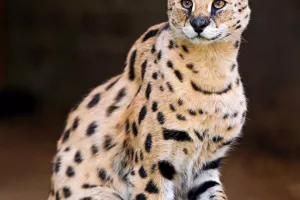The lovable giant panda is the rarest and most endangered species of bears. Their distinctive black-and-white markings, fluffy fur, and odd gait have earned them countless fans around the world. They are not carnivorous and aggressive like other bears, they seem to have little interest in mating, and their cubs are extremely vulnerable. All of this raises the question of why giant pandas survive for millions of years.
Currently, there should be only about 2,000 giant pandas in the wild, and it is difficult for such a population to have enough genetic diversity to ensure a competitive advantage. As we all know, humans have been saving giant pandas. If it were not for us, they would probably have gone extinct, and of course, the giant panda became an endangered species because of us.
An adult giant panda generally does not start breeding until 4 to 8 years old, and their reproductive capacity may last 12 to 16 years, but the lifespan of wild giant pandas is generally 18-20 years. What's more interesting is that they only ovulate once a year (in the spring), and the ovulation period is only a few days (usually no more than 3 days), and these days of the year are the only chance for a female panda to get pregnant. Once they miss this time, they have to wait another year. Even if the opportunity is so rare, male pandas don't seem to cherish it at all. It is said that the Research Base of Giant Panda Breeding is very distressed by this, and tried every means to make the pandas come into heat, and even let the pandas in the breeding season watch the mating video.
In the wild, giant pandas, like other bears, do not like to live in groups. They are solitary, territorial animals, so it is not an easy task for them to complete mating. If human structures block male and female pandas' areas, or if females experience any disturbance during ovulation, a full year's breeding opportunities are lost. If two pandas mate successfully, the gestation period is 95 to 160 days, and while they sometimes give birth to two cubs, usually only one survives. Cubs need to live with their mothers for two to three years, and in the best-case scenario, a wild female panda can successfully raise up to eight cubs in her lifetime.
Like other bears, omnivores or carnivores, giant pandas have short digestive systems, making them unsuitable for consuming bamboo, which is rich in fiber and poor nutrition. To get enough nutrition, giant pandas must eat a quarter of their body weight in bamboo every day, and they like to eat bamboo shoots, which are less nutritious. The lifestyle of giant pandas is the dream of many people. A giant panda spends 16 hours a day looking for something to eat. Basically, they sleep and eat every day. By any measure, giant pandas seem really hard to survive in the wild, some even think they are an evolutionary error, but they did live on their own for millions of years before being cared for by humans.
All creatures on earth are trying their best to adapt to the living environment, and giant pandas are no exception. When giant pandas split from the bear lineage about 8 million years ago, delicious and nutritious meat may have been hard to come by, and bamboo was ubiquitous. Eating bamboo may seem stupid, but it is the best choice for them, because it effectively reduces the pressure of competition, and many animals that only eat "good things" have become extinct. When giant pandas go deep into the bamboo forest, they rarely encounter natural enemies, because predators generally do not appear in the bamboo forest.
The giant pandas have made some physical adjustments, such as enlarged chewing muscles, said to have the fifth highest bite force among mammals, and they have slightly improved their digestive systems to accommodate their new food, bamboo. In addition, the most remarkable thing about the survival of giant pandas is that their metabolism is reduced, and the daily energy consumption of giant pandas is only 38% of other animals of similar size. That's because the panda has a mutation in a gene called DUOX2, which is involved in the synthesis of thyroid hormones, which control metabolic processes including energy expenditure. Eating bamboo makes it imperative for pandas to minimize energy expenditure in all aspects of their lives, which limits their movement and mating periods.
In addition, pandas are good tree climbers, their cubs can climb trees when they are 6 months old, they can also swim, and they do not hibernate like other bears. Any adult giant panda can protect itself from predators, but it is humans who make the giant panda's survival crisis.
Human development is always related to the destruction of the environment. The reduction of forest area has destroyed the habitat of giant pandas, making the habitat of giant pandas less and less. Growing populations, along with roads, dams, etc., have isolated solitary panda populations and reduced the available gene pool needed for healthy populations. Because they are not as aggressive as other bears, they attract many poachers, which makes the already difficult panda even more difficult. But humans are also the panda's greatest hope, and now we have done a very good job of protecting the giant panda.
Giant pandas are called living fossils, and history has witnessed their survivability. Like all animals, they all do well in their habitat without extreme environmental changes.


